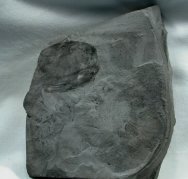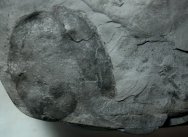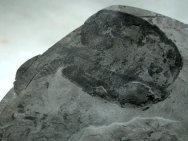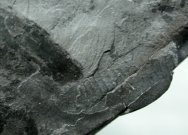Branchiocaris pretiosa
(Resser, 1929)
Phylum Arthropoda (Euarthropoda stem group)
or
Phylum Arthropoda, Subphylum Crustacea, Class Malacostraca, Subclass Phyllocarida
Geologic Time: Early Cambrian
Size: 68 mm long by 36 mm across
Fossil Site: Wheeler Shale, House Range, Utah
|
Branchiocaris
had a large carapace that protected the anterior body parts.
Its carapace structure hinged along the dorsal
edge in the same manner as seen in bivalves. Usually only the Besides
the Burgess Shale of British Columbia,
where it is also rare (less than .01% of the biota), Resser (1929) named the genus Protocaris and classified it as a phyllocarid crustacean, but other workers later considered it more closely related to trilobites. Four decades later Briggs (1976) erected the new genus Branchiocaris, prefering a stem arthropod status. Bergström (1997) later placed Branchiocaris was a calmanostracan branchiopod, while other's phylogenetic analyses placed it close to Marrella (Briggs, Fortey and Wills, 1992). Budd (2008) argued Branchiocaris to be a stem euarthropod, belonging to a clade also containing Odaraia, Fuxianhuia, Perspicaris and Canadaspis. Thus, Branchiocaris continues its enigmatic legacy. The subclass Phyllocarida contains three orders, one extant (Leptostraca, classified as a Malacostracan), and two extinct (Hymenostraca and Archaeostraca). Also See: Utah Cambrian Explosion Fossils References: |


 another
member of the genus (Branchiocaris yunnanensishas) is described
from the
another
member of the genus (Branchiocaris yunnanensishas) is described
from the 



